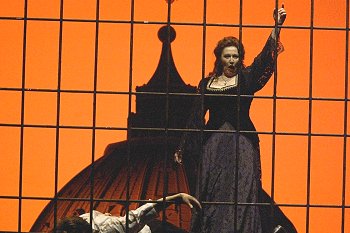Seen and Heard International
Review
G Puccini, Tosca
at the Finnish National Opera, April 15 2005 (GF)
Conductor: Kari Tikka
Director: Siegwulf Turek (revision by Anna Kelo)
Sets, costumes, lighting: Siegwulf Turek
Cast:
Tosca – Cynthia Makris (shared role with Päivi Nisula)
Cavaradossi – Raimo Sirkiä
Scarpia – Juha Uusitalo (shared role with Raimo Laukka)
Angelotti – Veli-Pekka Väisänen
Sacristan – Kalevi Olli
Spoletta – Pertti Mäkelä
Sciarrone – Jaakko Hietikko
Gaoler – Andrus Mitt
A Shepherd Boy – Oskari Pennanen

Päivi Nisula as Tosca
This production of Puccini’s thriller originally opened
in June 1995 and has been revived a number of times, the latest
revival opening on April 11 running until the end of the month.
It is very much a traditional Tosca with realistic sets, and how
else could this opera be presented? The libretto specifies the
exact times and locations and it is closely based on historical
fact. So, while visitors to the actual locations in Rome may not
recognize every detail it is still obvious that the first act
plays in the Sant’Andrea al Quirinale church where an enormous
construction is erected for Mario Cavaradossi to be able to paint
the altar-piece; that Scarpia’s room in Palazzo Farnese
in the second act is indeed very beautiful with chandeliers, candles
and period furniture (but I miss the fireplace) – a frightening
contrast to the horrible action that takes place; and the third
act plays on the slightly stylized roof terrace of Castel di Sant’Angelo
with the dome of St Peter’s church in the background.
Red is often the colour of life but in this opera – and
in this production – it is the colour of death. When Tosca
runs out of Scarpia’s room, having stabbed him to death,
she leaves the door half-open and lets a streak of red shine through
the opening and cross the dark stage. When dawn rises in Act III
the sky is as red as in Edward Munch’s famous Skriet.
It gradually fades away but returns at the end of the opera when
Cavaradossi is being shot – very realistically it has to
be said: standing with his back towards the audience the bullets
hit his chest and penetrate his body and the back of his white
shirt is coloured red, at once showing Tosca that the fake execution
was no fake execution.
Kari Tikka’s conducting was built very much on extremes:
in the dramatic moments, of which there are a lot, he whipped
up the tension to such a degree that the orchestra threatened
to drown the singers; in the lyrical moments he was almost dangerously
slow. But Tosca is indeed an opera built on contrasts
and there was not a dull moment during the performance.
In many ways Tosca “plays itself” –
there is no need for over-direction. In this case I thought that
the role of Angelotti was rather over-played, he felt almost parodical.
Pertti Mäkelä’s Spoletta was oily and threatening
enough, but here I must question his costume: an over-sized tailcoat
with enormous pink lapels. That’s more a dress for a clown
than a dangerous and terrifying police agent.
The singing was on a high level. Raimo Sirkiä has been a
pillar of strength for many years at the National Opera in dramatic
tenor roles and I have often admired him for his intensity and
care over phrasing. This time he wasn’t very comfortable
in the opening ‘Recondita armonia’, which was shaky
and strained, partly due to Tikka’s slow tempo. But he recovered
and during the rest of the first act his singing was glorious.
In the second act, what little he had to sing, he never really
found the kernel of his voice but his third act was up to standards
again. His phrasing and identification in ‘E lucevan le
stelle’ was excellent, though it has to be noted that the
freshness of voice to be heard on his Ondine recital made almost
15 years ago, was no longer there.
His real life partner, American soprano Cynthia Makris, was a
visually and vocally magnificent Floria Tosca: vibrant, powerful,
glistering top notes, cutting through the orchestra at the climaxes
and at the same time capable of an almost girlish timbre for the
more intimate moments. She delivered a ‘Vissi d’arte’
so scaled down, so free from theatricality, so unbearably resigned
– again at a very slow speed. I have never heard her as
good as this.
Magnificent is also the only adjective I can find for Juha Uusitalo’s
Scarpia. This bass baritone can obviously do anything. Just a
few days before Christmas he sang and acted the buffo part of
Don Magnifico in Rossini’s La Cenerentola to perfection.
Here he created a Scarpia of flesh and blood – no cardboard
villain. He has a tremendous power but also a lightness of touch
that is just as impressive. He quite often fined down his voice
to a tenor sound that made him even more frightening than the
more traditional brute. Here he ranged from seductive whisperings
to horrifying roars. A tremendous portrait of this chief of police.
The smaller parts were generally well taken with a black-voiced
but comically rather restrained Sacristan from Kalevi Olli. The
Shepherd Boy’s little solo in the third act should also
be mentioned, executed with a clear voice by Oskari Pennanen from
Cantores Minores.
To sum up: this is another production from the Finnish National
Opera that can be wholeheartedly recommended.
Göran Forsling
For an earlier review of Juha Uusitalo as Scarpia click HERE
Picture © Finnish National Opera

